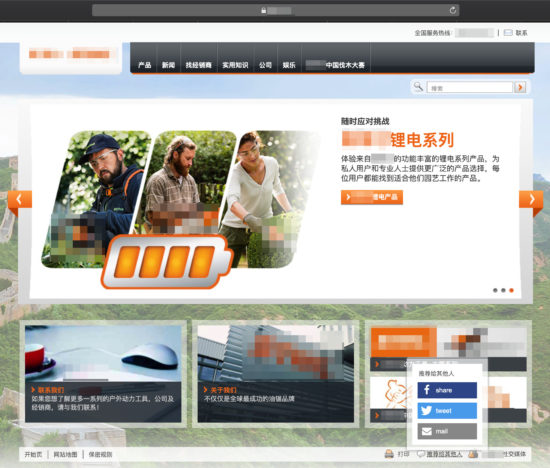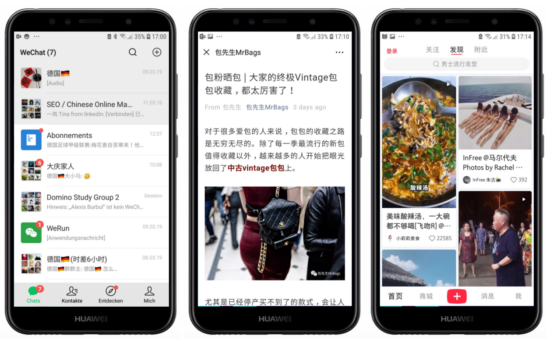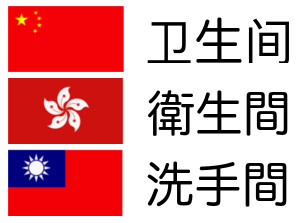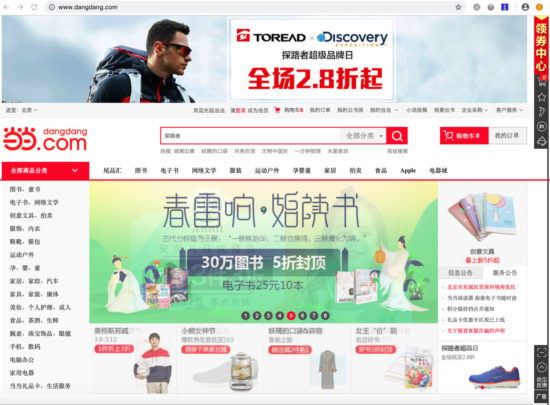China, as the biggest eCommerce market in the world, is a highly exciting prospect for website owners. As well as huge opportunities, there are also great challenges, not least because of the cultural, linguistic and technical differences between the web in China and what internet professionals in the Western hemisphere are used to. As 8 is the Chinese lucky number and superstition plays a strong role in Chinese culture, I would like to use this blog post to share the 8 most important SEO tips for Baidu, WeChat and the other giants of the China Wide Web.
This Chinese Checklist for SEO runs down the 8 most important points you need to be aware of when conducting search engine optimization in the Chinese market.
1. Don’t do SEO for transactional search terms – focus on informational keywords
Sales don’t usually take place in the online shops of manufacturers or merchants, so you shouldn’t be trying to drive traffic from search engines to your online shop. Chinese users mainly do their shopping on large, established platforms like Taobao, Tmall or Dangdang. Recommendation and influencer marketing activities mainly take place on social media, above all on WeChat.

But that’s just the transaction. Chinese users also want to be informed – and this can include a visit to the product manufacturer’s website. But in China, like anywhere else, this website has to be found, which means conducting a normal search engine search – and this is where traditional website SEO is relevant. Even if your brand is well-known in Europe or the USA and your website has authority with Google, you have to start from scratch in China. Baidu, So.com (360 Search) and Sogou.com are the search engines of choice for Chinese users. Bing is an example of a Western search engine that is accessible in China, but its market share is negligible. The image shows how diverse the SERPs can look in different search engines:

2. Great Firewall of China
The Great Firewall of China is a “protective barrier” set up by the Chinese government to – according to the official policy – protect the population from negative propaganda, pornography, fake media and hate speech. This has led to the government blocking social media websites like Facebook and Twitter that allow users to post unfiltered content that, from the government’s point of view, could be unethical or in bad taste. The Chinese internet has produced alternatives to all of these services that (have to) operate within the given restrictions and that delete content or user accounts that fail to comply with Chinese law.
As well as uncontrollable social media posts, other websites are blocked by firewall if they publish content that is illegal in China. Content and websites are not always blocked at domain level. IP addresses or even whole IP ranges can be blocked en masse.
3. Web-hosting in China
If a website is looking to be indexed and ranked by Baidu, then it doesn’t necessarily have to be hosted in China. In my article, Baidu Mythbusting, I address this and other common misconceptions about Baidu SEO. The reason many SEOs think they have to host a site in China is because they have had a bad experience with an unsuitable hosting provider. This can either mean that a site is blocked and unavailable in China, which will obviously mean it can’t rank in Baidu, or a site can be too slow to stand a chance in competitive niches.
When choosing a hosting provider (assuming you’re not in the privileged position of being able to host your website directly in China), you should therefore be extremely careful to ensure that your website isn’t blocked through no fault of your own. For the website’s speed, the distance between the hosting location and the Chinese border is a key factor. Hosting in Asia, particularly Hong Kong, South Korea or Japan, is recommended.
The dream ticket for a website hoping to rank well in the Chinese market is web-hosting within the People’s Republic of China itself. However, this requires an ICP licence which can only be granted to a company operating in China that has at least one branch/office in the People’s Republic. For international companies, a CDN, such as that provided by Akamai, is often a viable option. However, Akamai will only (be allowed to) deliver content from Chinese servers when the corresponding ICP licence has been obtained.
4. Page speed
Nowadays, almost every website needs a link to Facebook and a Twitter button. For SEO in China, this can contain hidden pitfalls. The main issue isn’t that Chinese users can’t make use of these links and could become frustrated. It’s the impact on availability and speed. It’s not uncommon for scripts (or individual page elements like graphics) to be loaded directly from these platforms or to try – even in a post-GDPR world – to communicate directly with Facebook, even without any user request.
This can lead to a considerable slowdown of the website or, in a worst case scenario, to the website ending up on a list of blocked domains because it is establishing too many connections to blocked services. For your Chinese audience, you should exchange any social media services that aren’t available for the most popular Chinese platforms. To see how you not should do it, take a look on this company website that has integrated the social icons from Facebook & Twitter:

In China, Tencent QQ and WeChat are the dominant social media channels that your website should connect to. Here are some example screens from WeChat – and from the social media app XiaoHongShu that is currently enjoying enormous hype:

JQuery, truetype fonts and web icons are other services that many web developers like to incorporate from the original sources, meaning that they aren’t self-hosted. This can create a problem because as the time it takes to load third-party resources can create a bottleneck for page speed optimization. This is, of course, equally true for websites in European and Chinese markets – but in China speed is considered more important as a slow page will tend to lose out to faster alternatives.
5. Chinese characters
Today, English is widely spoken amongst the young, urban Chinese population. However, China’s middle and upper class doesn’t only consist of young business professionals with an international education and outlook. The majority of Chinese consumers live, speak – and search – in Chinese. But not all Chinese is the same: A website that has been built for Hong Kong and is already ranking well on Google or Bing can struggle in China.
People in Hong Kong speak Cantonese, which won’t be understood by a native Mandarin speaker. Anyone who has studied the Chinese language is likely to reply that the different dialects and variants of Chinese, of which Mandarin and Cantonese are two, are spoken differently but written with the same characters. However, this is only superficially true because each variant has words and expressions that don’t appear in the others. This is, of course, true in other languages, for example with differences between Australian, American and British English. Below you can se how different characters in the respective Asian languages are – using the example of the word “toilet”:

With Chinese, there is another difference that separates Taiwan (where Mandarin is spoken like in mainland China) and Hong Kong from the People’s Republic: the character system. During the Cultural Revolution, several reforms were made to the traditional Chinese characters. These “simplified characters“ are only used in China (and partly in Singapore). In Hong Kong and Taiwan, Chinese is still written using the “traditional characters”. And while culture, lifestyle and customs in the Chinese countries (like Hong Kong, Taiwan, Singapore and the People’s Republic of China) may appear similar to a Western observer, dramatic changes in the last 50-60 years have created significant differences.
Content that is designed to appeal to Chinese users in China should therefore not only be written in Mandarin using simplified characters. It should also be drafted by Chinese native speakers who (particularly in the last ten years) have lived in China and been surrounded by the culture. This is the only way to ensure that the content does not just superficially tick the right boxes, but that it also takes into consideration the latest developments in China’s rapidly-changing internet culture and is therefore able to appeal to users living in China.
6. Colors, design and layout
Chinese culture is fundamentally different from Western culture. This isn’t a question of religion – Chinese culture includes a whole world of (subconscious) symbolism, meanings of colors, expectations of structure and principles of layout.
- Many Chinese people are superstitious. For example, the number 4 is avoided (e.g. in telephone numbers) and the numbers 6 and 8 are considered desirable.
- The color red, which signifies danger or a warning signal in Europe, represents happiness and gifts in China. At the Chinese spring festival, children are given “Hong Bao” (red envelopes) containing money and, on Chinese holidays, the internet community enjoys virtual Hong Bao with discounts and special offers.
- While the trend for Western website design is often to include white space and use unobtrusive colors, many Chinese websites are full of vibrant colors and flashing images that can seem chaotic to Western observers.
These points underline the importance of working with Chinese consultants and designers to prepare a brand and website for the Chinese market. Once this has been taken care of, you can look at traditional onpage and offpage SEO measures.

Just like Western search engines, Baidu recognizes the topic of a page by analyzing keywords in the title, meta description, headlines and content. Baidu also analyzes links to other websites to assess how important a page is within the China Wide Web, and Baidu also punishes attempted manipulation like link spam, and it rewards genuine links from authoritative Chines pages (like large online newspapers). Good PR and press work, combined with social media and influencer marketing, are ways of being noticed by influential websites and gaining valuable links.

7. Long-tail keywords
For many valuable keywords, the first search results page of Baidu and 360 Search is full of results from the search engines’ own web offerings (Baidu’s own Wiki, discussion forums, Q&A portals, image and video verticals etc.) or results from the other giants of the Chinese internet, such as Taobao, 1688.com etc.
This often makes it impossible to rank in the top 10 for many short-head keywords. However, Chinese users (like their European or American counterparts) often use more detailed, long-tail search queries instead of short, single-word terms.
These long-tail terms are often not targeted as precisely by the internet giants as they can be by landing pages that are built specifically for long-tail keywords. This is where real opportunities for success in Chinese SEO lie.
Well over half of internet activity in China takes place on smartphones and voice search has also been adopted by the older generation. The natural language that users speak into their phones, and the sheer number of people in China, mean that long-tail keywords can have a high search volume leading to a significant number of site visitors.
8. Conclusion: Recipe for Chinese SEO Success
The three main ingredients of successful Chinese SEO are:
- Ensure your site is and remains accessible in China,
- Understand and serve the Chinese market,
- Find and occupy your own (long-tail) niche alongside the internet giants.
